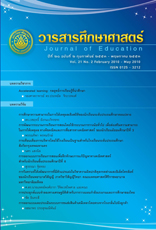รูปแบบความสัมพันธ์โครงสร้างเชิงเส้น ของปัจจัยที่ส่งผลต่อประสิทธิผลของเครือข่ายสถานศึกษาในภาคตะวันออกเฉียงเหนือ The Linear Structural Equation Model of Factors Affecting School Network Effectiveness in the Northeastern Part of Thailand
Keywords:
ประสิทธิผลของเครือข่ายสถานศึกษา, ปัจจัยของเครือข่ายสถานศึกษา, school network factors, school network effectivenessAbstract
บทคัดย่อ
การวิจัยครั้งนี้มีวัตถุประสงค์ เพื่อศึกษาระดับประสิทธิผลของเครือข่ายสถานศึกษา ความสัมพันธ์เชิงสาเหตุของปัจจัยที่ส่งผลต่อประสิทธิผลของเครือข่ายสถานศึกษา และสร้างรูปแบบความสัมพันธ์โครงสร้างเชิงเส้นสำหรับการอธิบายประสิทธิผลของเครือข่ายสถานศึกษาในภาคตะวันออกเฉียงเหนือ กลุ่มตัวอย่างในการวิจัย คือ เครือข่ายสถานศึกษา สังกัดสำนักงานเขตพื้นที่การศึกษาหนองคาย มุกดาหาร มหาสารคาม นครราชสีมา และศรีสะเกษ จำนวน 311 เครือข่ายสถานศึกษา เครื่องมือวิจัยเป็นแบบสอบถามมาตราส่วนประมาณค่า 5 ระดับ สถิติที่ใช้ในการวิเคราะห์ข้อมูล ได้แก่ ค่าเฉลี่ย ค่าเบี่ยงเบนมาตรฐาน ค่าสัมประสิทธิ์ความแปรผัน ค่าคะแนนต่ำสุด ค่าคะแนนสูงสุด ค่าความเบ้ และค่าความโด่ง การวิเคราะห์ความสัมพันธ์เชิงสาเหตุใช้ค่าสัมประสิทธิ์สหสัมพันธ์แบบเพียร์สัน และการวิเคราะห์ถดถอยพหุแบบปกติและแบบขั้นตอน และการสร้างรูปแบบใช้การวิเคราะห์เส้นทาง ด้วยโปรแกรม LISREL 8.30
ผลการวิจัยปรากฏ ดังนี้
1. ระดับประสิทธิผลของเครือข่ายสถานศึกษา โดยรวมอยู่ในระดับมาก ส่วนรายด้านอยู่ในระดับมาก 2 ด้าน คือ ความพึงพอใจของบุคลากร และการบริหารจัดการอย่างเป็นระบบ ตามลำดับและอยู่ในระดับปานกลาง 2 ด้าน คือ การปรับตัวเข้ากับสภาพแวดล้อม และการช่วยเหลือกันของสถานศึกษา ตามลำดับ
2. ปัจจัยที่ส่งผลต่อประสิทธิผลของเครือข่ายสถานศึกษา ด้านลักษณะของเครือข่ายสถานศึกษา ลักษณะของสภาพแวดล้อม ลักษณะของบุคลากร และลักษณะของนโยบายการบริหารและการปฏิบัติ ร่วมกันส่งผลทางบวกต่อประสิทธิผลของเครือข่ายสถานศึกษา ร้อยละ 58 อย่างมีนัยสำคัญทางสถิติที่ระดับ 0.001 ส่วนรายด้าน พบว่า ลักษณะของนโยบายการบริหารและการปฏิบัติ ลักษณะของสภาพแวดล้อม และลักษณะของเครือข่ายสถานศึกษา ส่งผลทางบวกมากตามลำดับ อย่างมีนัยสำคัญทางสถิติที่ระดับ 0.001
*นิสิตระดับดุษฎีบัณฑิต สาขาวิชาการบริหารการศึกษา มหาวิทยาลัยวงษ์ชวลิตกุล จ.นครราชสีมา
3. รูปแบบความสัมพันธ์โครงสร้างเชิงเส้นสำหรับการอธิบายประสิทธิผลของเครือข่ายสถานศึกษา พบว่า ลักษณะของนโยบายการบริหารและการปฏิบัติ มีอิทธิพลทางตรงเชิงบวกต่อประสิทธิผลของเครือข่ายสถานศึกษามากที่สุด รองลงมาได้แก่ ลักษณะของสภาพแวดล้อม และลักษณะของเครือข่ายสถานศึกษา ตามลำดับ ส่วนอิทธิพลทางอ้อม ลักษณะของนโยบายการบริหารและการปฏิบัติ มีอิทธิพลทางอ้อมเชิงบวกมากที่สุด รองลงมาได้แก่ ลักษณะของบุคลากร และลักษณะของสภาพแวดล้อม ตามลำดับ สำหรับอิทธิพลรวม ลักษณะของนโยบายการบริหารและการปฏิบัติ ลักษณะของสภาพแวดล้อม ลักษณะของบุคลากร และลักษณะของเครือข่ายสถานศึกษา มีอิทธิพลรวมเชิงบวก มากตามลำดับ
Abstract
The purposes of this dissertation were to study the levels of school network effectiveness, the casual relation of factors affecting school network effectiveness, and to build the linear structural equation model for an explanation of the school network effectiveness in the northeastern part of Thailand. The sample group consisted of 311 school networks under the offices of basic education in Nong Khai, Mukdahan, Mahasarakham, Nakhon Ratchasima and Sri Saket Provinces in B.E. 2552. The research tool was a questionnaire. The statistics used for school network effectiveness were mean, standard deviation, coefficient of variation, minimum score, maximum score, skewness, and kurtosis, for the casual relation were Pearson’correlation coefficient, ordinary and stepwise multiple regression analysis, and for building the linear structural equation model was path analysis, using LISREL 8.30.
The research results were as follows :
1. The level of school network effectiveness as a whole was high, as classified by aspects, two aspects were high : the personnel satisfaction, and systematic management. For a moderate level, there were two aspects : the adaptiveness to the environment, and the assistance of each other between schools.
2. The factors affecting school network effectiveness were the school network characteristics, the environmental characteristics, the personnel characteristics, and the managerial policies and practice characteristics. These factors affected positively to the school network effectiveness and were accounted for 58 percent, with statistical significance level at 0.001. As classified by aspects, it was found that the managerial policies and practice characteristics, the environmental characteristics, and the school network characteristics affected positively to the school network effectiveness, with the statistical significance level at 0.001
3. As regards the linear structural equation model for an explanation of the school network effectiveness, it was found that the managerial policies and practice characteristics exerted direct and positive influence on the school network effectiveness to the most extent. Next level of influence was the environmental characteristics, and the school network characteristics, respectively. For indirect influence, it was found that the managerial policies and practice characteristics exerted positive and indirect influence to the most extent on the school network effectiveness. The next level of influence was the personnel characteristics, and the environmental characteristics. As for the whole influence, the managerial policies and practice characteristics, the environmental characteristics, the personnel characteristics, and the school network characteristics exerted positive influence on the school network , respectively, in terms of magnitude.
Downloads
How to Cite
Issue
Section
License
บทความทุกบทความเป็นลิขสิทธิ์ของวารสารศึกษาศาสตร์ มหาวิทยาลัยบูรพา



